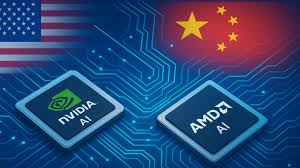
The US has secured a 15% AI chip revenue share from Nvidia and AMD as part of the deal to secure export licenses to China. Exports of chips to China had previously been banned due to national security concerns until the ban was lifted on July 14.
The Deal: A 15% Revenue Share for Market Access
On Monday, 11 August, Trump held a meeting with Nvidia and AMD to discuss revenue share with their trade with China. Chip sales to China had been previously halted during the US-China trade war that started in April 2025. And only last month was the ban lifted.
The meeting held on Monday was the final aspect to lifting the ban and also giving official export licenses to Nvidia and AMD. However, it didn’t go without a price. According to Reuters, the initial negotiation for market shares started at 20% before the final agreement for 15% was reached.
Under the agreement, both companies will individually remit 15% of their AI chip sales to the US government. The chips in question are Nvidia’s H20 chip and AMD’s MI308 chips, which are specifically designed for the Chinese market.
For Nvidia, which earned $17 billion from China in its last fiscal year (13% of total sales), and AMD, with $6.2 billion (24% of total revenue), this deal could mean the inflow of millions of dollars to the U.S. government.
Nvidia and AMD have confirmed their compliance with the deal. Nvidia stated, “We obey the rules the US government sets for our participation in worldwide markets.” While AMD has not directly addressed the revenue-sharing agreement, its spokesperson commented on the U.S. approval to export their chips.
Why This Matters: Balancing National Security and Economic Gain
Let’s digress a little by talking about the main reason behind the chip ban. According to reports, the U.S. government had suspicions about China using the chips they bought for military purposes. And as a result, it became a concern for national security.
Using the premise of a national security threat and the trade war as a base for the ban, it was pretty much put into effect without much deliberation. However, this isn’t the only way the U.S. has tried to suppress China’s technological prowess.
Years before the ban, trade restrictions had already been put into place to limit the capacity of chips that can be sold to China. And that’s why Nvidia and AMD had to come up with lesser chips to maintain trade with China.
China, on the other hand, had no choice but to comply, as they couldn’t locally make chips that were on par with the kind they bought from the U.S. However, during the period of the trade ban, they have been forced to come face-to-face and find solutions to this reality.
The limitation, however, lies with the fact that even if China makes a breakthrough with AI chips, they might not be able to meet up with the local demand. And the U.S. is very aware of this fact, which set up the basis of the deal.
The 15% revenue share approach for the U.S. is a way to not only gain extra revenue but to make China reliant on U.S. technology. This way the U.S. can also indirectly control the level of tech China has access to.
Economic Implications for AMD and Nvidia
For AMD and Nvidia, this deal is like a double-edged sword. On one hand, it gives them access to resume trade with China, a market responsible for a significant part of their revenue, and on the other, they are liable to lose/remit 15% of their revenue from those sales to the U.S. Government.
News of this deal has caused a mixed reaction among investors and stakeholders alike. During the pre-trading period on August 11, both companies experienced slight stock dips, with Nvidia down 1.16% and AMD down 2.3%.
The Chinese market, however, is not one that can be let go of entirely. Hence, both companies have more to gain by resuming trade, albeit at a cost.
What’s Next?
It is not totally certain how the resumed trade with China will go in the long run. China’s foreign ministry has previously accused the U.S. of using technology and trade measures to “maliciously contain and suppress China.”
Also, there are mixed reactions as to the legality of the 15% revenue share. “Regardless of whether you think Nvidia should be able to sell H20s in China, charging a fee in exchange for relaxing national security export controls is a terrible precedent,” wrote Peter Harrell, a leading expert on US economic statecraft.
“In addition to the policy problems with just charging Nvidia and AMD a 15% share of revenues to sell advanced chips in China, the US Constitution flatly forbids export taxes,” he added.
Whichever way this deal turns out, a new precedent will be set, which will influence both sides. Should the deal hold, it will redefine how tech giants navigate global markets. And if it doesn’t, the world will be on the lookout for what breakthrough China will come up with.
